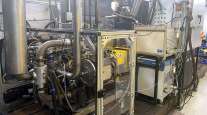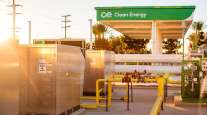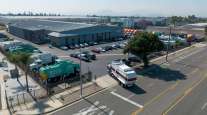Trucking’s Use of Liquefied Natural Gas Hindered By Dearth of Fueling Stations
By Dan Leone, Staff Reporter
This story appears in the Sept. 6 print edition of Transport Topics.
Trucking executives, fuel vendors and manufacturers of aftermarket engine technology said it is easier to get an alternative-fuel vehicle onto a motor carrier’s lot than it is to get a viable alternative fuel into a truck’s tank. But some fleets are willing to experiment with alternative-fuel sources anyway, even if it means a more intimate relationship with their fuel supply chains.
For instance, natural gas, which advocates both public and private are now pushing hard as a commercial transportation fuel, is plentiful underground but rare aboveground.
Liquefied natural gas is the supercooled form of the fuel most practical for hauling heavy loads over a great distance, those who manufacture natural-gas trucks and engines have said.
These manufacturers already make LNG-powered trucks that they would be pleased to sell to carriers — albeit at a substantial premium over a standard diesel truck. However, a continental dearth of LNG filling stations has proven to be a large obstacle for carriers that are using, or might be inclined to use, LNG.
“It would be very difficult today to take a longhaul tractor and run it from the West Coast to the East Coast on LNG,” said Scott Perry, group director of vehicle supply management for Ryder System, Miami, Fla.
Claude Robert, chief executive officer of Canadian hauler Transport Robert and its parent, Groupe Robert, Boucherville, Quebec, agreed. “The volume and availability of refueling stations are the bottleneck right now,” he said.
Robert would know. He has decided to put 130 natural gas-powered tractors into linehaul service in two of the freight lanes served by his company — Montreal to Quebec City, a haul of less than 200 miles; and Montreal to Toronto, about a 340-mile trip.
Neither of those lanes is anywhere near as long as Transport Robert’s LNG-powered trucks can go between fill-ups. But neither lane has any natural gas filling stations.
So, to make linehaul with an LNG truck a business reality, Transport Robert is building natural gas refueling stations at its own terminals. The company plans to buy 50 LNG trucks this year, Robert said. The 130 natural gas tractors the carrier plans to have in service by 2015 would represent 20% of its total fleet.
“If the availability of LNG would extend in Canada and the U.S.A., our proportion [of natural gas trucks] will increase accordingly.”
Here in the United States, about 1,000 natural gas trucks are in commercial service, said Greg Roche, director of business development for Clean Energy Fuels Corp., Seal Beach, Calif.
“Most of those, the vast majority in fact, are running in Southern California,” Roche told Transport Topics.
This is not a coincidence, he said.
“The ball got rolling in the ports [of] Los Angeles and Long Beach and their clean-truck program,” said Roche. He told TT that the ports’ program “was kind of the catalyst that kick-started the natural gas truck industry.”
The sometimes controversial clean-truck program eventually will ban all vehicles that don’t meet the federal government’s 2007 emissions standard from entering the ports.
As a result, Roche said, some truck buyers — particularly those doing drayage work at the two ports — have angled for local, state and federal subsidies to help them purchase trucks that run on natural gas.
Ryder, in a move that natural gas proponents have cheered, will buy more than 200 heavy-duty natural gas-powered trucks to add to its rental and leasing fleets in Southern California.
As with any alternative fuel proposition, there is some government assistance involved.
A government coalition called the San Bernardino Associated Governments got hold of some federal stimulus money from the Department of Energy earlier this year, and Ryder has been a beneficiary.
Together, SANBAG, as the coalition calls itself, and Ryder will embark on a $19.3 million project under which the leasing giant will buy 202 heavy-duty trucks that burn natural gas. If all goes according to plan, from 50 to 70 of these trucks will be available by the end of the year, Perry said.
Ryder, like Transport Robert, also will become an operator of natural gas refueling stations.
The leasing giant plans to construct fueling facilities on three of its own properties in Southern California. Filling stations have longer lead times than the trucks they eventually will service, and Ryder estimates that its fuel pumps will be ready sometime in the first quarter of 2011.
Westport Innovations Inc., a Canadian company based in Vancouver, British Columbia, sees Ryder’s involvement as a positive sign for the future of alternative fuel vehicles. Westport works with engine maker Cummins Inc., Columbus, Ind., on natural gas conversions for big-truck engines.
“The rental fleet market is an area of particular interest,” said Jonathan Burke, vice president of market development for Westport’s GX heavy-duty, 15-liter engine. “Initially, operators are a little bit gun-shy of natural gas technology.” Placing more natural gas trucks with rental companies “would be a way for [fleets] to test the technology.”
But the lack of available LNG fueling stations is the reason that most natural gas trucks in the United States aren’t venturing far from the nation’s busiest West Coast shipping ports, said Roche at Clean Energy.
Ryder has rental and leasing customers in Southern California that run loads outside of the Los Angeles basin, Perry told TT, but even those customers wouldn’t roam very far east in the their natural gas trucks — because LNG fueling stations outside of the Southwest are virtually nonexistent. Clean Energy and other natural gas proponents are working aggressively to change the situation.
In 2010, however, selective LNG availability is a reality.
For now, commercial truckers can use retail natural gas filling stations in the Los Angeles area to roam as far as Las Vegas and Phoenix.
Clean Energy “is working on natural gas lanes between San Diego to the San Francisco Bay area, Phoenix, Las Vegas and Salt Lake City,” Roche said.
The company is also carving out a “triangle” of fueling stations that would allow natural gas trucks to haul between Houston, Dallas and San Antonio in Texas, Roche said.




